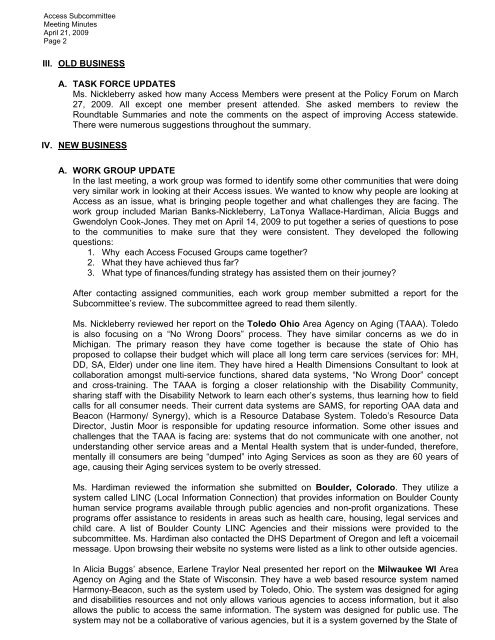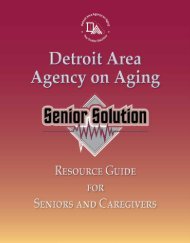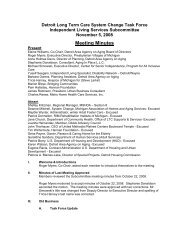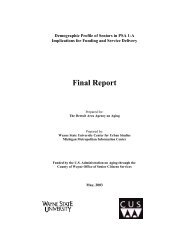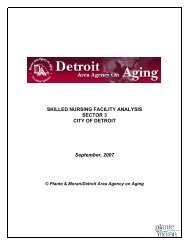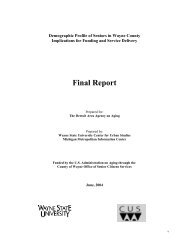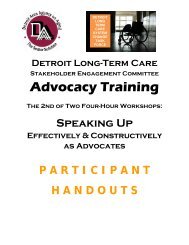Meeting Minutes - Detroit Area Agency on Aging
Meeting Minutes - Detroit Area Agency on Aging
Meeting Minutes - Detroit Area Agency on Aging
You also want an ePaper? Increase the reach of your titles
YUMPU automatically turns print PDFs into web optimized ePapers that Google loves.
Access Subcommittee<br />
<str<strong>on</strong>g>Meeting</str<strong>on</strong>g> <str<strong>on</strong>g>Minutes</str<strong>on</strong>g><br />
April 21, 2009<br />
Page 2<br />
III. OLD BUSINESS<br />
A. TASK FORCE UPDATES<br />
Ms. Nickleberry asked how many Access Members were present at the Policy Forum <strong>on</strong> March<br />
27, 2009. All except <strong>on</strong>e member present attended. She asked members to review the<br />
Roundtable Summaries and note the comments <strong>on</strong> the aspect of improving Access statewide.<br />
There were numerous suggesti<strong>on</strong>s throughout the summary.<br />
IV. NEW BUSINESS<br />
A. WORK GROUP UPDATE<br />
In the last meeting, a work group was formed to identify some other communities that were doing<br />
very similar work in looking at their Access issues. We wanted to know why people are looking at<br />
Access as an issue, what is bringing people together and what challenges they are facing. The<br />
work group included Marian Banks-Nickleberry, LaT<strong>on</strong>ya Wallace-Hardiman, Alicia Buggs and<br />
Gwendolyn Cook-J<strong>on</strong>es. They met <strong>on</strong> April 14, 2009 to put together a series of questi<strong>on</strong>s to pose<br />
to the communities to make sure that they were c<strong>on</strong>sistent. They developed the following<br />
questi<strong>on</strong>s:<br />
1. Why each Access Focused Groups came together?<br />
2. What they have achieved thus far?<br />
3. What type of finances/funding strategy has assisted them <strong>on</strong> their journey?<br />
After c<strong>on</strong>tacting assigned communities, each work group member submitted a report for the<br />
Subcommittee’s review. The subcommittee agreed to read them silently.<br />
Ms. Nickleberry reviewed her report <strong>on</strong> the Toledo Ohio <str<strong>on</strong>g>Area</str<strong>on</strong>g> <str<strong>on</strong>g>Agency</str<strong>on</strong>g> <strong>on</strong> <strong>Aging</strong> (TAAA). Toledo<br />
is also focusing <strong>on</strong> a “No Wr<strong>on</strong>g Doors” process. They have similar c<strong>on</strong>cerns as we do in<br />
Michigan. The primary reas<strong>on</strong> they have come together is because the state of Ohio has<br />
proposed to collapse their budget which will place all l<strong>on</strong>g term care services (services for: MH,<br />
DD, SA, Elder) under <strong>on</strong>e line item. They have hired a Health Dimensi<strong>on</strong>s C<strong>on</strong>sultant to look at<br />
collaborati<strong>on</strong> am<strong>on</strong>gst multi-service functi<strong>on</strong>s, shared data systems, “No Wr<strong>on</strong>g Door” c<strong>on</strong>cept<br />
and cross-training. The TAAA is forging a closer relati<strong>on</strong>ship with the Disability Community,<br />
sharing staff with the Disability Network to learn each other’s systems, thus learning how to field<br />
calls for all c<strong>on</strong>sumer needs. Their current data systems are SAMS, for reporting OAA data and<br />
Beac<strong>on</strong> (Harm<strong>on</strong>y/ Synergy), which is a Resource Database System. Toledo’s Resource Data<br />
Director, Justin Moor is resp<strong>on</strong>sible for updating resource informati<strong>on</strong>. Some other issues and<br />
challenges that the TAAA is facing are: systems that do not communicate with <strong>on</strong>e another, not<br />
understanding other service areas and a Mental Health system that is under-funded, therefore,<br />
mentally ill c<strong>on</strong>sumers are being “dumped” into <strong>Aging</strong> Services as so<strong>on</strong> as they are 60 years of<br />
age, causing their <strong>Aging</strong> services system to be overly stressed.<br />
Ms. Hardiman reviewed the informati<strong>on</strong> she submitted <strong>on</strong> Boulder, Colorado. They utilize a<br />
system called LINC (Local Informati<strong>on</strong> C<strong>on</strong>necti<strong>on</strong>) that provides informati<strong>on</strong> <strong>on</strong> Boulder County<br />
human service programs available through public agencies and n<strong>on</strong>-profit organizati<strong>on</strong>s. These<br />
programs offer assistance to residents in areas such as health care, housing, legal services and<br />
child care. A list of Boulder County LINC Agencies and their missi<strong>on</strong>s were provided to the<br />
subcommittee. Ms. Hardiman also c<strong>on</strong>tacted the DHS Department of Oreg<strong>on</strong> and left a voicemail<br />
message. Up<strong>on</strong> browsing their website no systems were listed as a link to other outside agencies.<br />
In Alicia Buggs’ absence, Earlene Traylor Neal presented her report <strong>on</strong> the Milwaukee WI <str<strong>on</strong>g>Area</str<strong>on</strong>g><br />
<str<strong>on</strong>g>Agency</str<strong>on</strong>g> <strong>on</strong> <strong>Aging</strong> and the State of Wisc<strong>on</strong>sin. They have a web based resource system named<br />
Harm<strong>on</strong>y-Beac<strong>on</strong>, such as the system used by Toledo, Ohio. The system was designed for aging<br />
and disabilities resources and not <strong>on</strong>ly allows various agencies to access informati<strong>on</strong>, but it also<br />
allows the public to access the same informati<strong>on</strong>. The system was designed for public use. The<br />
system may not be a collaborative of various agencies, but it is a system governed by the State of


